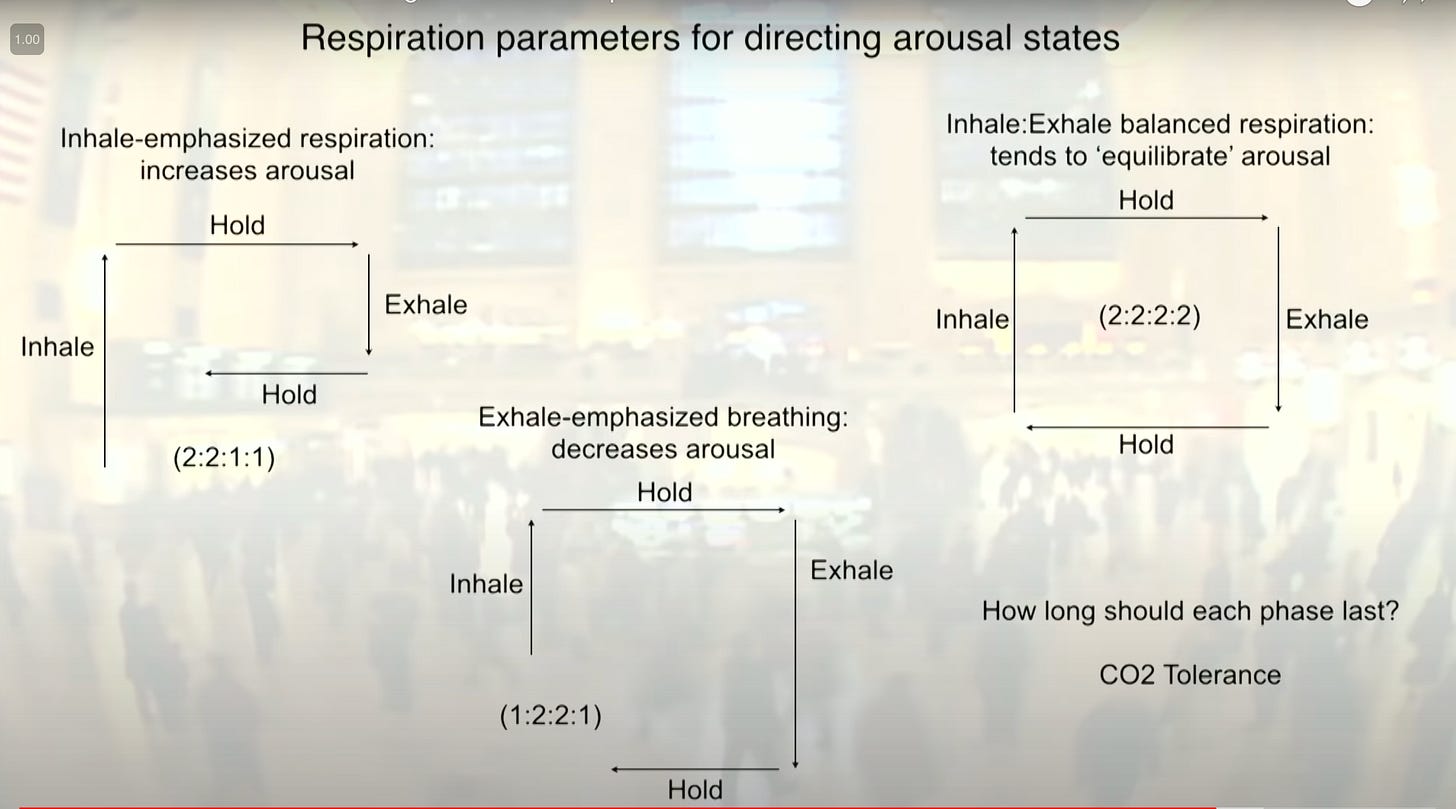What Whit’s Wondering #17
This weeks musings: on breathwork for alertness, the importance of free speech, and self-directed neuroplasticity.
One productivity hack:
Use different breathing patterns to change your level of alertness as needed to optimize your performance in various activities.
(photo from Dr. Huberman’s slides from the YouTube video linked above)
Feeling sleepy but need to perk up quickly? Emphasize the inhalation portion of your breathing cycle in a 2:2:1:1 pattern. So you can inhale for 4 seconds, hold for 4 seconds, exhale for 2 seconds, hold for 2 seconds, repeat. Thus 2:2:1:1.
Just finished an intensely focused work session before bed that’s left you highly alert? Emphasize your exhalation in a 1:2:2:1 ratio* to decrease your level of arousal and help you wind down. Try inhaling for 2 seconds, holding for 4, exhale for 4, holding for 2, and repeat.
At a good level of calm focus and want to maintain this steady state? Practice box breathing in an even 1:1:1:1 ratio. So inhale, hold, exhale, and hold for 4 seconds each.
[*To be honest, a 1:1:2:2 ratio emphasizing the exhalation hold was more intuitive to me, but I’ll just share what his slides note. In most interviews, Huberman doesn’t really emphasize the holds, but recommends doing 2 inhalation sniffs followed by a long exhale (physiological sigh) to calm the nervous system down quickly.]
One text I’m reading:
All Minus One is an abridged and beautifully illustrated version of the second chapter of John Stuart Mill’s On Liberty.
It is a vitally important refresher on the importance of free speech in a time where people seem to be more divided than ever.
Mill’s basic lesson was the timeless truth that we need each other—even our opponents—more than we realize. We all tend to be arrogant and overconfident that “our side” is right. We all suffer from the “confirmation bias”—the tendency to search only for evidence that will confirm our existing beliefs and prejudices. This is why diversity is so important, particularly diversity of viewpoints: The only reliable cure for the confirmation bias is interacting with other people who have a different confirmation bias, and who do you the favor of criticizing your ideas. Mill believed that the pursuit of truth required the collation and combination of ideas and propositions, even those that seem to be in opposition to each other. He urged us to allow others to speak—and then to listen to them—for three main reasons.
First, the other person’s idea, however controversial it seems today, might turn out to be right. (“The opinion may possibly be true.”)
Second, even if our opinion is largely correct, we hold it more rationally and se- curely as a result of being challenged. (“He who knows only his own side of the case, knows little of that.”)
Third, and in Mill’s view most likely, op- posing views may each contain a portion of the truth, which need to be combined. (“Conflicting doctrines share the truth be- tween them.”)
This 19th century philosopher believed in humility, openmindedness, and constantly checking the validity of your ideas, especially when they seem to conveniently match those of your peers.
Mill’s main concern was not government censorship. It was the stultifying consequences of social conformity, of a culture where deviation from a prescribed set of opinions is punished through peer pressure and the fear of ostracism.
Even if Mill’s excerpts are dense, the introduction itself is a great overview and reminder of why we should be careful to not pigeonhole ourselves within certain labels, ideas, or social circles.
…our identity as a person must be kept separable from the ideas we happen to endorse at a given time. Otherwise, when those ideas are criticized, we are likely to experience a conversation, book, or lecture as an attack upon our self, rather than as an opportunity to think about something more deeply.
One concept I’m actively integrating into my life:
I’ve been looking for ways to use self directed neuroplasticity to rewrite my negative, self-limiting thoughts into more empowering ones. As Dr. Hanson explains, mental activity changes neural structure— you can “use your mind to change your brain to change your mind for the better.”
When the same neural circuits fire over and over again, these pathways are reinforced and strengthened, thus “hard-wiring” certain thought patterns. And for many of us, the thoughts that have been reinforced for years since childhood are usually self-critical.
In order to break this, we can actively focus our attention on more positive thoughts, thereby creating new neuronal pathways that encode these thoughts. With time and lots of active practice, the desirable neural circuits will become strengthened and more automatic while the negative thought patterns will become dormant and pruned away.
In the upcoming weeks, I will be discussing a few different methods we can use to implement self-directed neuroplasticity.
One tool I am looking to try out is positive affirmations, which brings me to…
One song I’m listening to on repeat:
I was scrolling through Instagram one day and watched a travel blogger’s reel that used this song. Before I could even comprehend the lyrics, I was already dancing along to the beat. Some of the ideas are a bit woo-woo for me, but overall, this positive energy affirmation song is incredibly uplifting and empowering.
Everything that I need, I already have
Everything that I have is all that I need
Anything I desire, I will receive
Because my reality is created by me
I am successful, I am peaceful, I am free, I am wise
I am potential energy, and like a phoenix I shall rise
I am healthy, I am wealthy, I am power, I am talent
I am mind, I am body, I am spirit, I am balance
I am enlightened, I am fearless, I am outside the realm of time
I am part of the all, and I am one with the divine
Energy Energy Energy
All around on the outside and into me
There is no hate in my heart, I even have love for my enemies
Energy Energy Energy
I adore this creator’s positive vibes, messages of self-love, and mission to empower people to create their own destinies. Now excuse me while I turn this clip into a ringtone.
One quote I’m reflecting on:
“Many of our fears are based on the workings of the ego, the part of us that’s focused on getting recognition and protecting from social ostracism.” -Gay Hendricks


